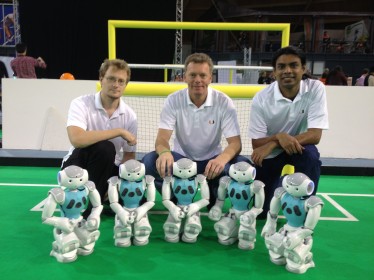
RoboCanes recently competed in the 2013 Robo World Cup. From left are graduate student Andreas Seekircher, professor Ubbo Visser, and graduate student Saminda Abeyruwan.
While the 2014 FIFA World Cup is still a year away, another international soccer event recently astounded a fan base of a different sort in Eindhoven, The Netherlands, with a group of University of Miami graduate students among the competitors. Led by UM professor of computer science Ubbo Visser, the University of Miami’s robotic soccer team, RoboCanes, competed in two divisions at the RoboCup world championships.
Approximately 2,500 contestants from 40 countries competed in this year’s event, displaying the technological prowess of their robots not only in soccer matches but also in rescue, service, and dancing competitions.
“The quality of the teams improved significantly this year,” said Visser. “Specifically, the new teams made a big jump, including our RoboCanes team. I’m very proud of our graduate students.”
While spectators are often awed by the robots’ skill level, RoboCanes is more than simply an event that appeals to the public. Ever since its launch 16 years ago, its goal has remained the same: to speed the development of reliable, low-cost robotic technology to serve an aging society and by the mid-21st century, to field a fully autonomous humanoid robot soccer team capable of defeating the most recent winner of the FIFA World Cup.
At this year’s competition, held June 30, the RoboCanes squad competed in two divisions. In the Standard Platform League, soccer is played with a standardized robot platform in which all teams compete with identical robots, differing only in the software they develop. The robots operate autonomously, without external control by humans or computers. The robots are capable of communicating with their teammates and receiving decisions issued by referees via wireless communication. Each game is composed of two 10-minute halves, with teams of five robots playing against each other on a 9-meter x 6-meter field.
The 3D simulation league focuses on team cooperation and strategy. Independently moving software players play soccer on a virtual field inside a computer. The humanoid robot models are copies of the physical robot used in the Standard Platform League. The challenge is to develop new technologies that allow autonomous robots to act appropriately in real-time and dynamic environments.








